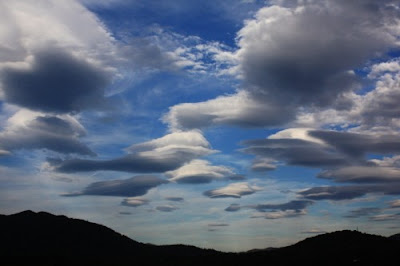
http:// Physics Photo of the Week March 18, 2022 - originally published Sept. 10, 2010 It looks like an invasion of flying saucers invading the Swannanoa Valley. Actually these are lenticular clouds - clouds that are shaped like lenses. This is an unusual display that occurred Sept. 9, 2010 and lasted from before 5:30 pm until past sunset 3 hours later. These clouds are even more spectacular when viewed with a time-lapse animation shown in the picture below. The time lapse animations are often published as UFO's. In the animation 30 frames are played back at 20 frames per second. The images were taken 10 seconds apart. This represents 5 minutes of clouds condensed to 1.5 seconds - a speed-up factor of 200. Notice how the clouds are all stationary as the winds blow through them. These stationary patterns kept their place in the sky at least an hour. Notice also that high level cirrus clouds can be seen in the back...
